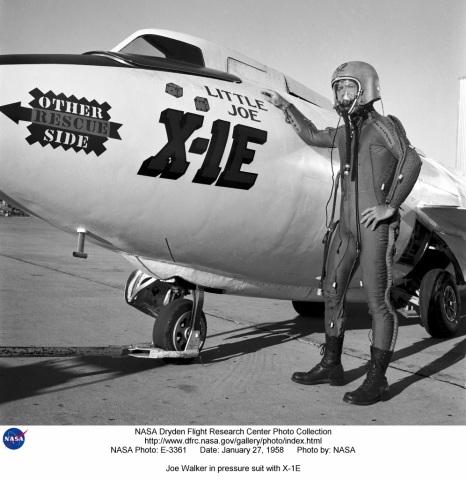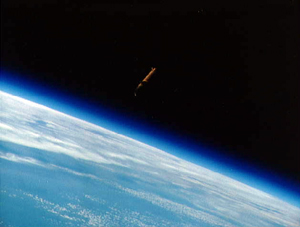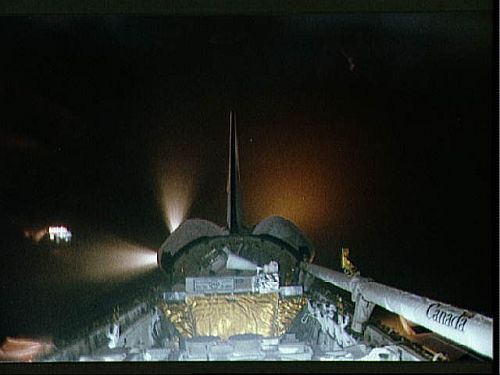The Edge of Space
Today, astronaut Michael Barratt asks, where exactly is the border of space? The University of Houston's College of Engineering presents this series about the machines that make our civilization run, and the people whose ingenuity created them.
Where does space begin? The answer is, "it depends." Defining space implies some threshold of removal from all that earth has to offer its objects and inhabitants.
For the human leaving earth, the dominant factor is the increasingly rarified atmosphere. Above 15,000 feet, we need supplemental oxygen. Above 35,000 feet, not even 100% oxygen is enough unless it's supplied under pressure. At 50,000 feet, outside pressure is lower than the physiologic gas pressure in the lung; getting oxygen into the blood is impossible without a pressurized cabin or pressure suit. At 63,000 feet, known as Armstrong's line, outside pressure is roughly the same as vapor pressure of water at body temperature. Exposed unprotected, you could expect the sensation of saliva boiling off your tongue for the few seconds before you passed out from hypoxia.

The X-1E, one of an elite group of high flying test aircraft. A service ceiling in excess of 90,000 feet required its pilots to wear pressure suits. Joe Walker stands beside his high altitude, supersonic ride."
At higher altitudes, space is defined by the performance of the machines that take us there. 50 miles is the arbitrary altitude at which the US Air Force awards astronaut wings. These were given to pilots of the X-15 rocket plane in the '60s. 62 miles is the altitude identified by Hungarian aeronautics legend Theodore von Karman, above which wings would be practically ineffective. The World Air Sports Federation uses this altitude to certify that a craft has gone from airspace to space. Here atmospheric light scattering is minimal, and the so-called 'blackness of space' prevails. Traveling through 124 miles, most would agree we are in space. The density of particles and hence aerodynamic drag is low enough that a sustainable orbit is possible. A typical human spacecraft reaches this altitude in about 8 1/2 minutes.

Earth's atmosphere as viewed from the Space Shuttle. Beautiful, fragile, and relatively thin.
The International Space Station orbits at about 220 miles, a little more than the distance between New York City and Washington D.C. Decide for yourself whether the term "outer space" is appropriate. Above 440 miles, the atmosphere is so thin that any remaining air molecules will almost never hit one another. Continuing outward, particle density gradually diminishes over thousands of miles, approaching the free space density of 1-10 particles per cubic centimeter.
The UN Treaty for the Peaceful Use of Outer Space dictates that space is the province of all mankind. For a sovereign nation, the question is, where does airspace give way to outer space, and we lose our jurisdiction? Where this border should be set remains unsettled and is a keen topic for international space law.
But step back from that issue. The very question of where space begins smacks of arrogance, of geocentrism. It's akin to the non-traveled inhabitants of a tiny island debating where the sea begins. A more appropriate question might be, "where is the border of earth in the vast ocean of space?"
I'm Michael Barratt at the University of Houston, where we're interested in the way inventive minds work.
End notes:
The issue of where space begins in the process of leaving earth was addressed before machines and people ever made the trip. In the Journal of Aviation Medicine in 1951, Huburtus Strughold cited three main functions of the atmosphere that help understand these limits. These are (1) the function of supplying breathing air and climate; (2) the function of supplying a filter against cosmic factors (e.g., ionizing radiation, ultraviolet light, meteoroids); and (3) the function of supplying mechanical support to the craft. Although you can define altitudes for such milestones, even these are a bit fuzzy. Different aircraft and spacecraft have different needs for aerodynamic lift and engine performance, and no two human bodies are exactly alike. But with these concepts and the basic knowledge of these altitudes, we can design machines and environments to enable the spaceflight capabilities of today. There are several other limits which are used by the aerospace community en route to space, some of which are outlined in our book Principles of Clinical Medicine for Space Flight.
The transition to physiologic vacuum deserves special mention, but first a word about pressure. We often use the units of pounds per square inch (psi) and millimeters of mercury (mmHg) to measure the pressure of the atmosphere. At sea level, pressure is close to 14.7 psi, or 760 mmHg. The human body's oxygen requirement is supplied by the atmosphere quite nicely; of that 760 mmHg, 160 mmHg is oxygen. Ascend to altitude, and the portion of oxygen becomes inadequate for the body's needs. Our metabolism produces carbon dioxide as a byproduct, and passes this to the lung, typically at a pressure of 40mmHg. Water vapor is also passed into the lung, at a pressure of 47mmHg. This is the so called vapor pressure of water at body temperature. The combined pressure of these physiologic gases, 87mmHg, is the same as the atmosphere at roughly 50,000 ft. Theoretically, no respiratory exchange is possible here. The more interesting event comes at 63,000 ft; here the outside pressure roughly equals 47mmHg, the point at which water at body temperature turns to vapor. From this point on, the body is at physiologic vacuum and may as well be in space. Of course protective environments and artificial atmospheres are needed far below this point. Have you ever seen "high altitude cooking instructions" on the back of a food pack that requires boiling? It is this same phenomenon at work; water boils at a lower temperature when the outside pressure is lower, requiring a longer cooking time.
Wherever you decide to plant the "welcome to space" sign, a few things are certain. The machine that takes you there will not be able to make use of atmospheric oxygen as a jet engine does; rocket engines are needed, with artificial supplies of both fuel and oxygen. Without sufficient atmospheric density for wings and control surface to react against, maneuvering will also require small rockets. And finally the human will require an artificial environment, supplying pressure, a breathable atmosphere, shielding from intense ultraviolet radiation from the sun as well as ionizing radiation from magnetically trapped particles and solar wind, and all other sundries needed for the voyage.

In orbit, wings and aerosurfaces are useless for control. Vehicles must use small rocket engines to point themselves in a desired direction. Here rocket plumes from the maneuvering jets on a Space Shuttle are seen.
When you think about it, traveling in earth orbit does not mean we are particularly distant from earth. The 220 mile orbiting altitude of the International Space Station (ISS) highlights a couple of important points. First, it is more the relative speed that separates us from the ground; we have to be traveling about 17,500 mph to sustain our orbit. Second, the atmosphere that protects our planet and makes life possible is not very thick. Viewed from space, this beautiful blanket or air appears thin and fragile.
A footnote to this discussion. Although the ISS orbits quite happily at 220 miles, even at this altitude there are sufficient encounters with atmospheric molecules to drag us down over time. Several tons if propellant are used each year to keep the orbit of the ISS from decaying into the thick layers of the atmosphere.
References:
Strughold H, Harber H, Buettner K, et al. Where does space begin? Functional concepts at the boundaries between atmosphere and space. J Aviat Med 1951; 22:342�349.
Barratt, M. Physical and Bioenvironmental Aspects of Human Space Flight. In: Principles of Clinical Medicine for Space Flight. M Barratt and S Pool, editors. pp. 3-26. Springer-Verlag, NY. 2008
Human Spaceflight; Mission Analysis and Design. Wiley Larson and Linda Pranke, editors. McGraw-Hill Companies, Inc.
Bio:
Michael Barratt is a NASA astronaut and physician, with specialties in internal and aerospace medicine. He came to the Johnson Space Center in 1991, where he worked for 9 years as a project physician and space flight surgeon. Working with the joint US / Russian programs involving the Space Shuttle and the Mir space station, Dr. Barratt was able to work with a new set of colleagues in the Russian space medical community. Selected as an astronaut in the class of 2000, Dr. Barratt made his first flight in 2009 aboard a Russian Soyuz, and spent 199 days in flight during a tour of duty on the International Space Station. He remains active in the space medical community, serving as associate editor for space medicine for the journal Aviation, Space, and Environmental Medicine, and is senior editor of the text "Principles of Clinical Medicine for Space Flight."